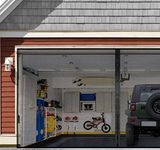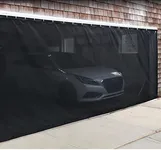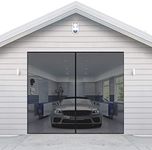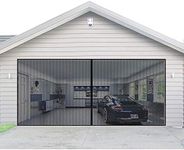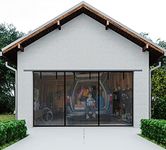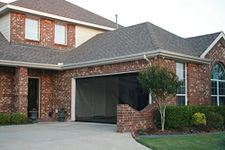Buying Guide for the Best Garage Door Screen Kits
Choosing the right garage door screen kit can make your garage a more comfortable and versatile space, whether you want to keep bugs out, let fresh air in, or create a temporary outdoor room. To find the best fit, think about how you plan to use your garage, the climate in your area, and how often you’ll be opening and closing the screen. Understanding the key features will help you make a choice that matches your needs and lifestyle.Screen MaterialScreen material refers to the type of fabric or mesh used in the kit. This is important because it affects durability, airflow, and how well the screen keeps out insects and debris. Common materials include fiberglass mesh, polyester, and heavy-duty vinyl. Fiberglass mesh is lightweight and allows good airflow, making it suitable for mild climates and occasional use. Polyester is more durable and can handle frequent use or pets. Heavy-duty vinyl is best for those who need extra strength or weather resistance. Choose a material based on how much wear and tear you expect and whether you need extra protection from the elements or pets.
Size and FitSize and fit refer to the dimensions of the screen kit and how well it matches your garage door opening. This is crucial because a poor fit can leave gaps for bugs or reduce the effectiveness of the screen. Kits usually come in standard sizes, but some are adjustable or can be trimmed. Measure your garage door opening carefully and compare it to the kit’s specifications. If your garage door is an unusual size, look for customizable options. The right fit ensures the screen works as intended and looks neat.
Mounting MethodThe mounting method describes how the screen attaches to your garage door frame. This matters because it affects installation difficulty, stability, and how easily you can remove or retract the screen. Common methods include hook-and-loop (Velcro), magnetic strips, or tracks. Hook-and-loop is easy to install and remove, making it good for temporary use. Magnetic strips allow for quick entry and exit but may not be as secure in windy conditions. Track systems are more permanent and sturdy, ideal for frequent use. Choose a mounting method that matches how often you’ll use the screen and whether you want a temporary or permanent solution.
Opening StyleOpening style refers to how you enter and exit through the screen. This is important for convenience and accessibility. Some screens have a center zipper, others use magnetic closures, and some slide open on a track. Zippered screens provide a secure seal but may require two hands to open. Magnetic closures are hands-free and self-closing, which is great for kids or carrying items. Sliding screens offer a more traditional door-like experience. Think about who will use the screen and how often, then pick an opening style that fits your daily routine.
Visibility and AirflowVisibility and airflow describe how much light and air pass through the screen. This affects comfort and how much you can see outside while the screen is closed. Finer meshes block more bugs but may reduce airflow and visibility, while coarser meshes let in more air and light but may not keep out smaller insects. If you want a bright, breezy garage, look for screens with larger mesh openings. If bug protection is your top priority, choose a finer mesh. Consider your climate and how you plan to use the space when deciding what balance is best for you.
Ease of InstallationEase of installation refers to how simple it is to set up the screen kit. This is important if you plan to install it yourself or want to move it between seasons. Some kits require only basic tools and can be put up in minutes, while others need more time and effort. If you prefer a quick, DIY project, look for kits labeled as easy or tool-free installation. If you want a more permanent or professional look, be prepared for a more involved setup. Match the installation process to your comfort level and how often you plan to use or remove the screen.
